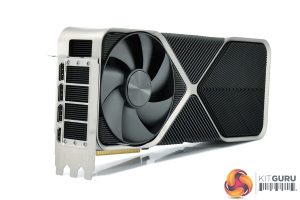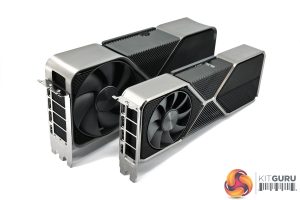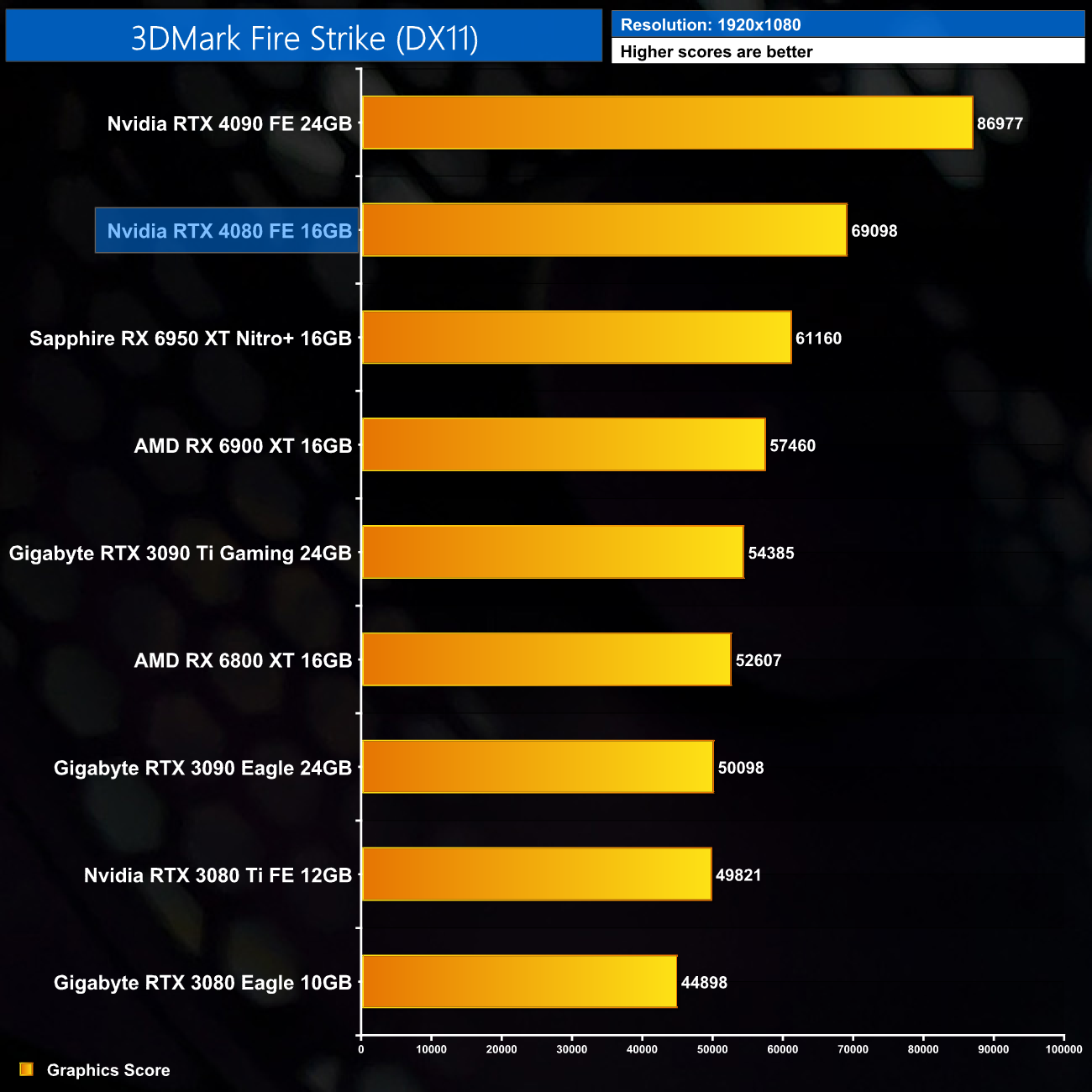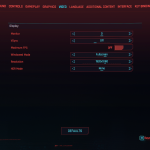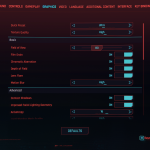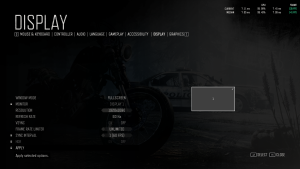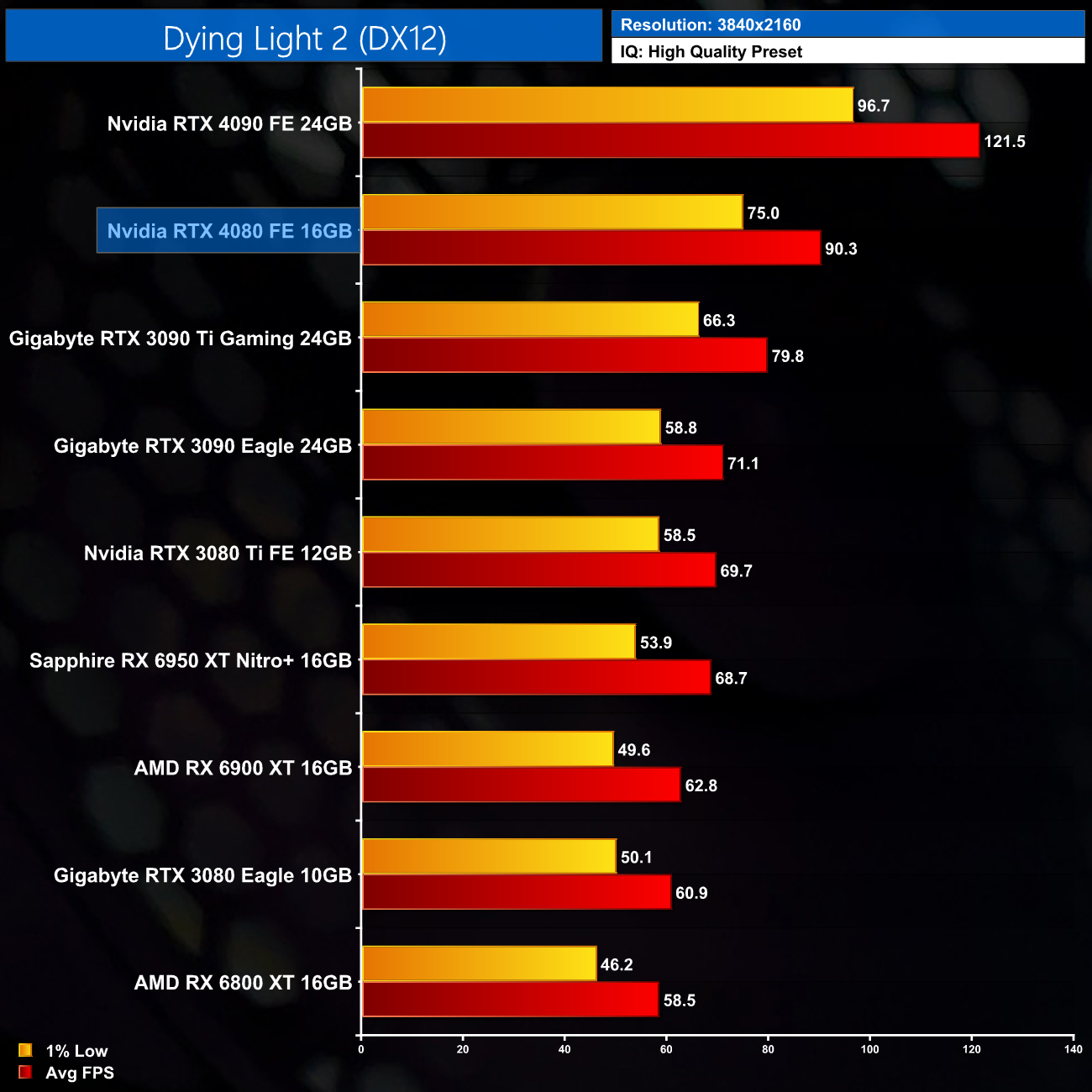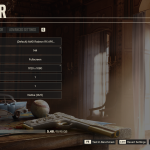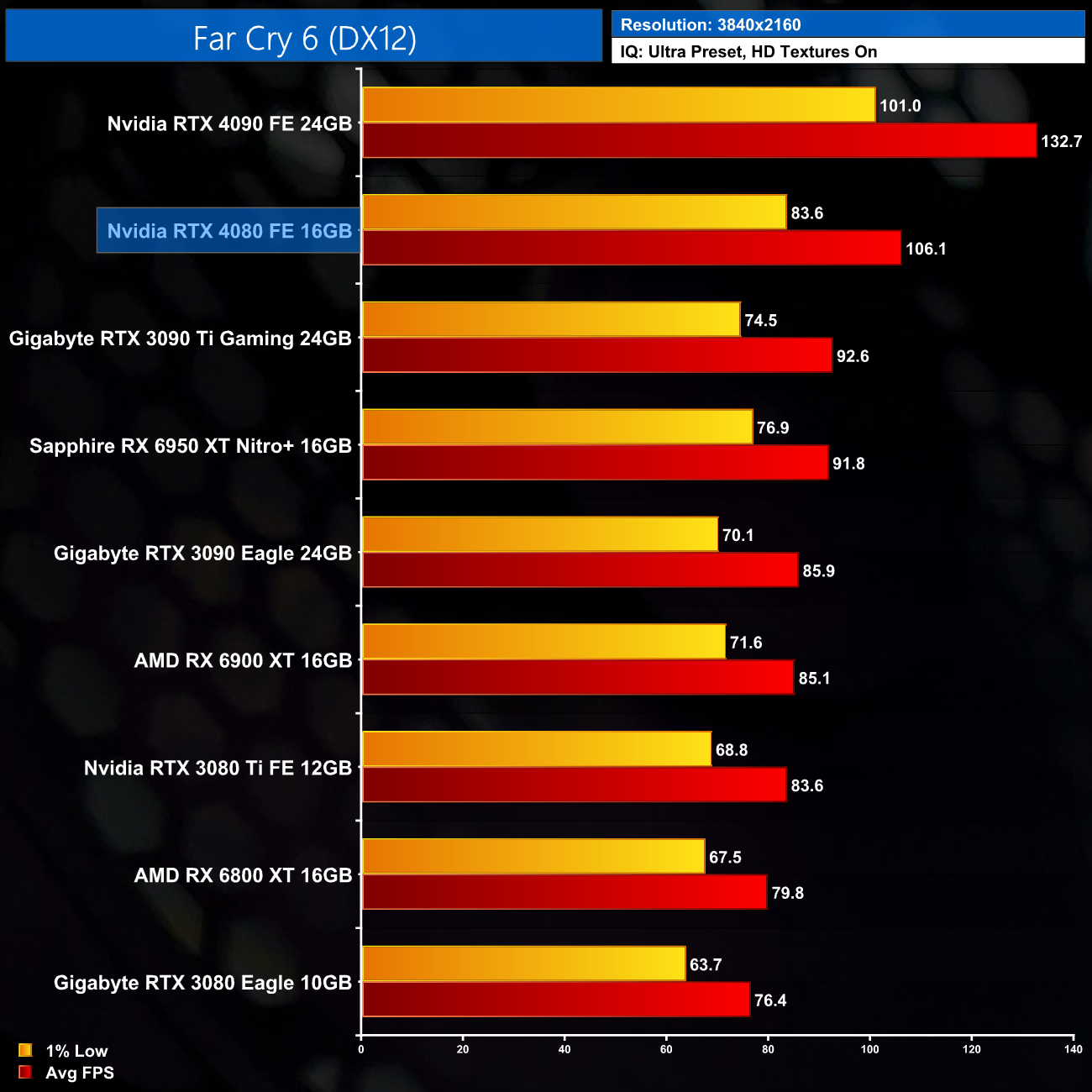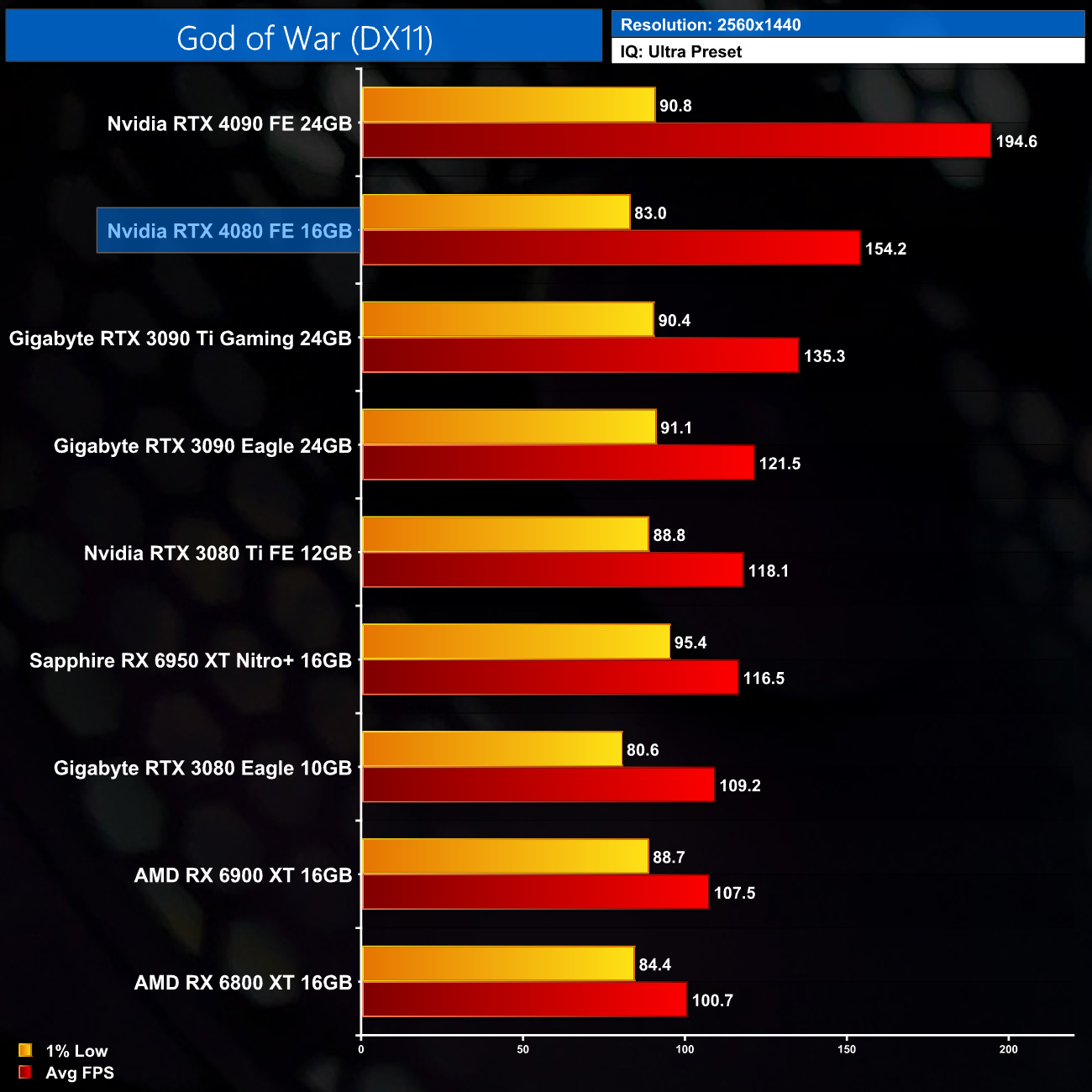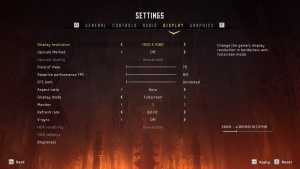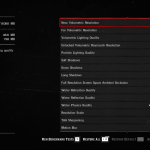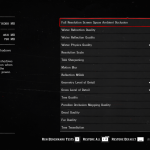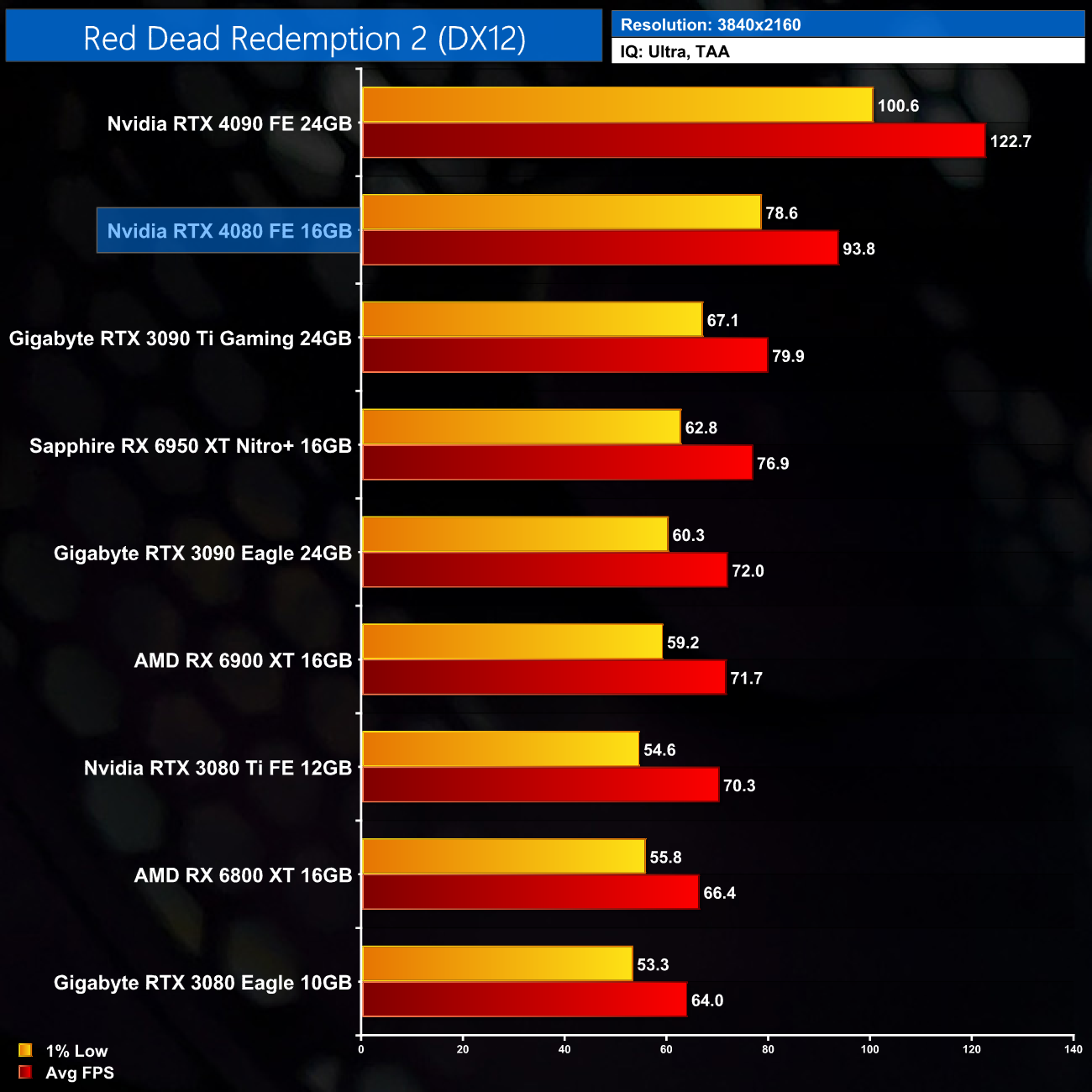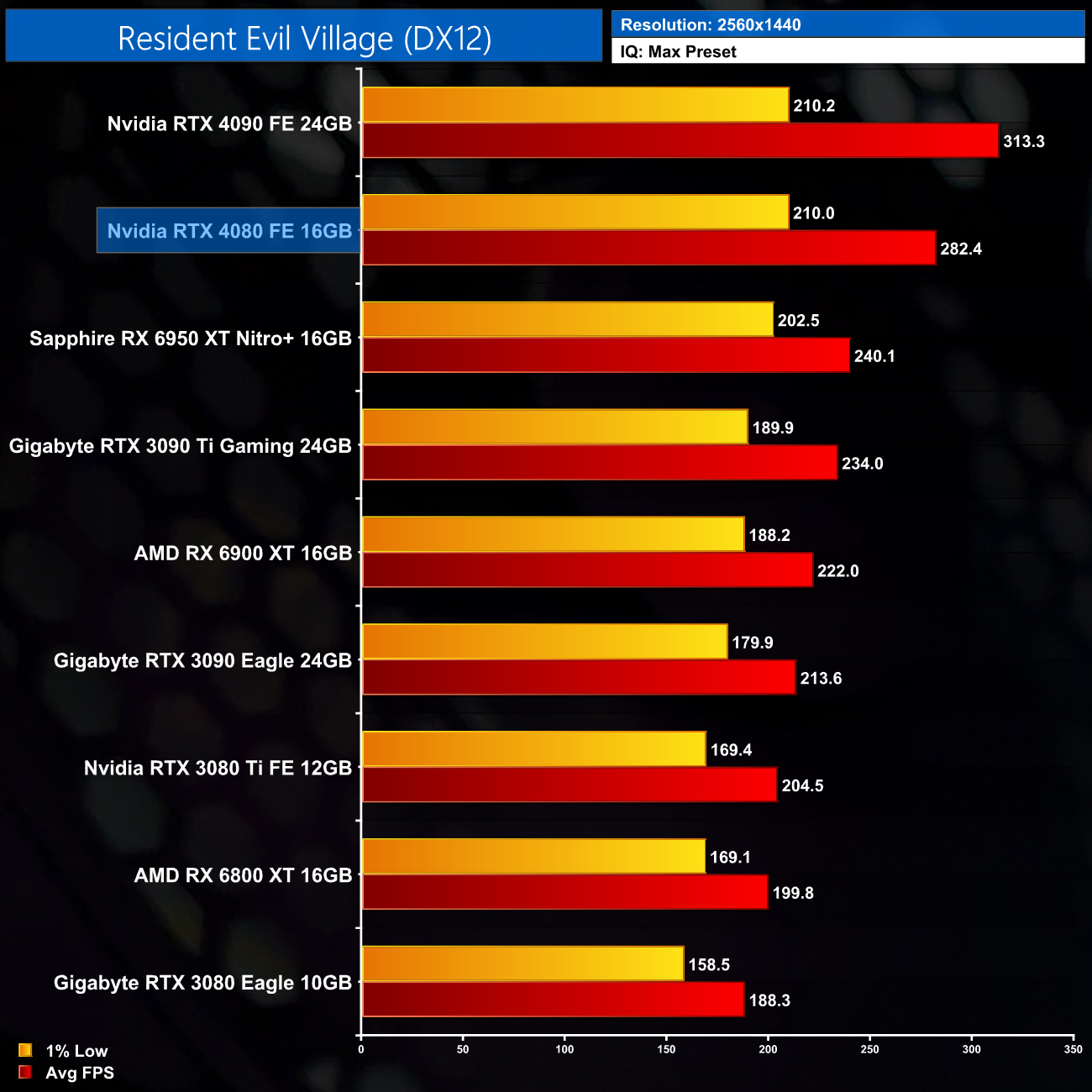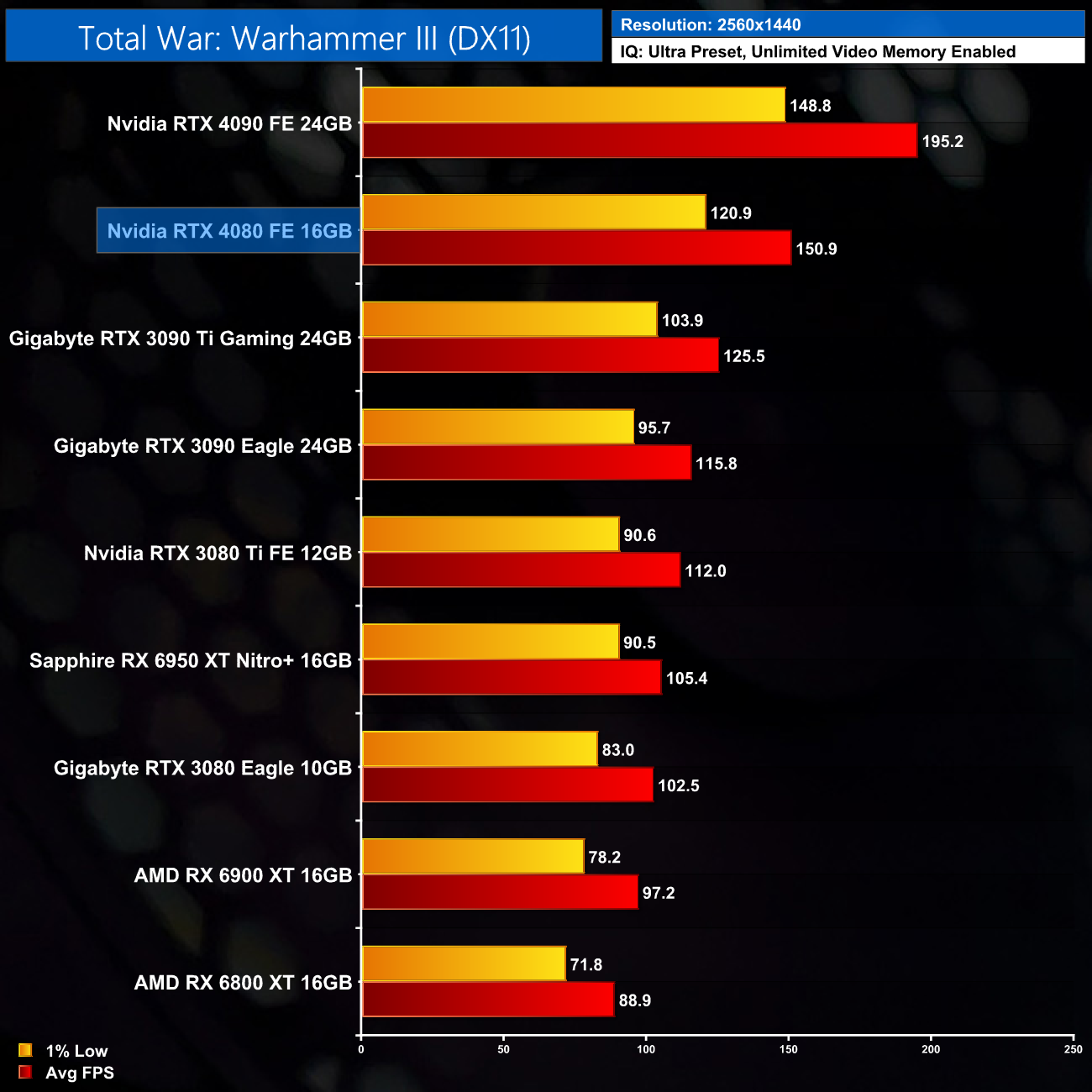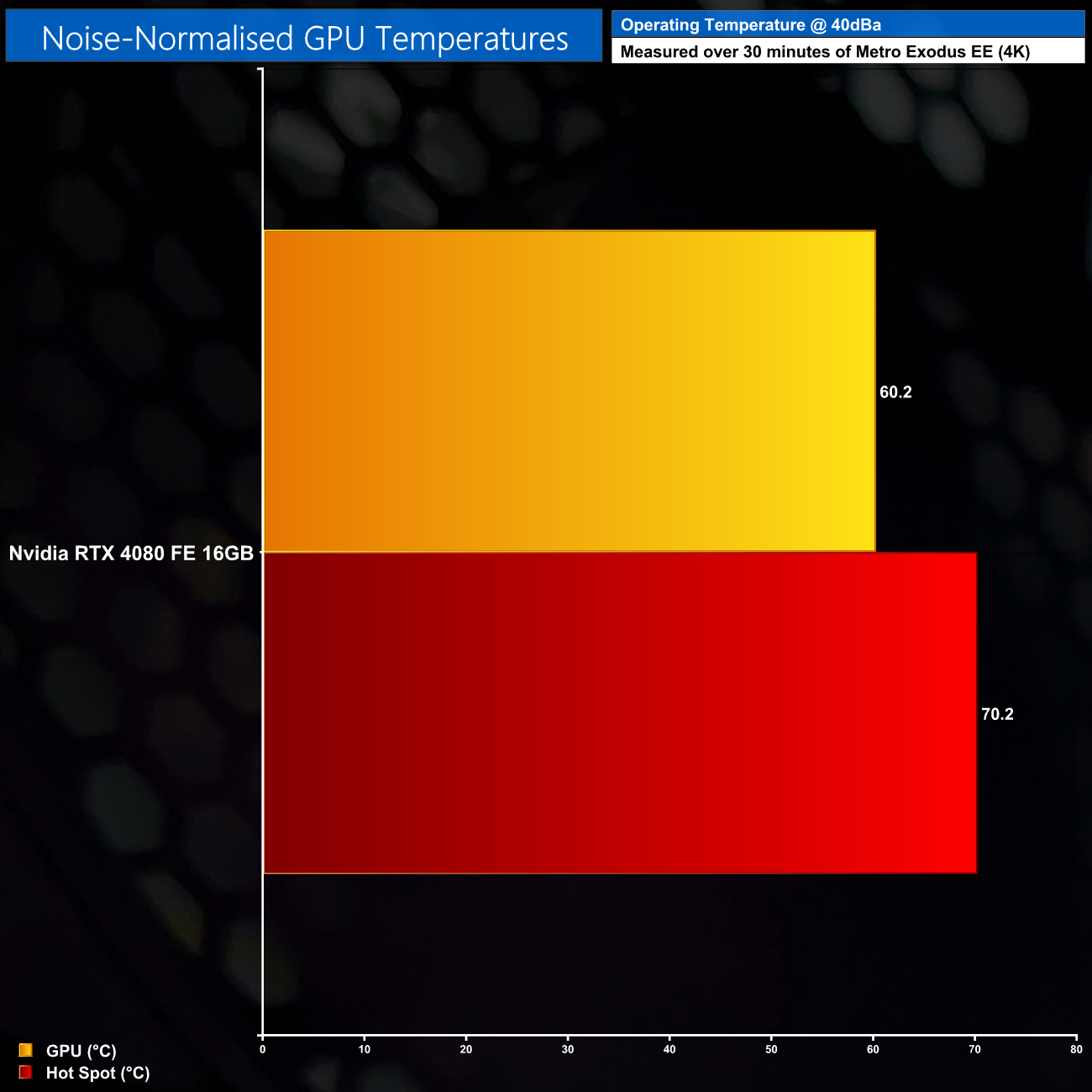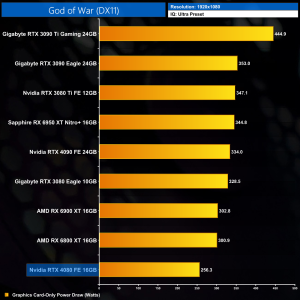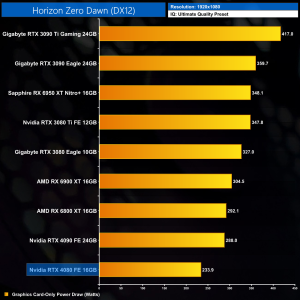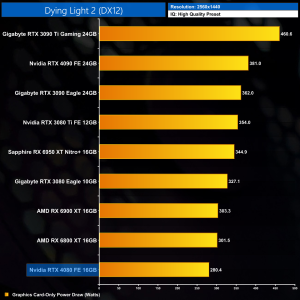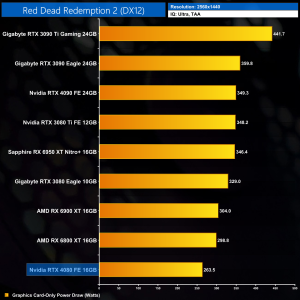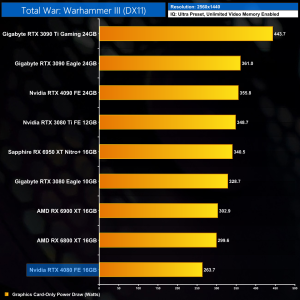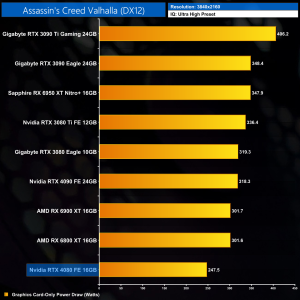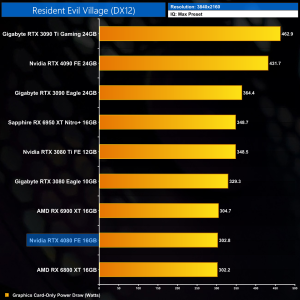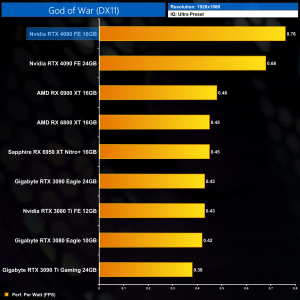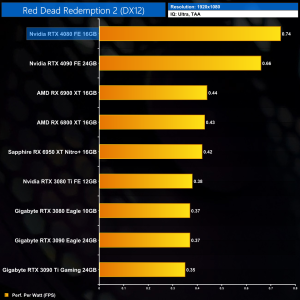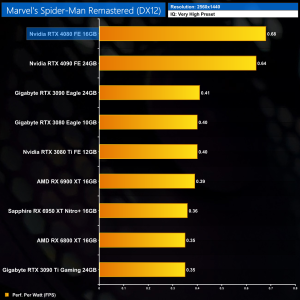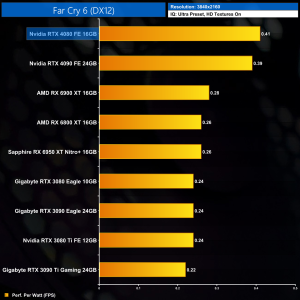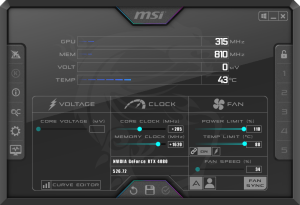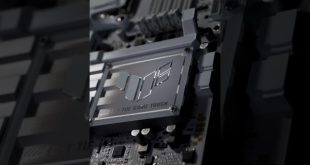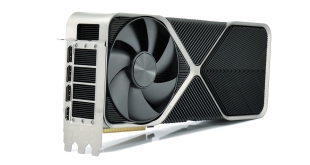
Today's launch would have marked the release of the first of two RTX 4080 SKUs… but as we know, the RTX 4080 12GB was summarily ‘unlaunched' just weeks after its initial announcement. The RTX 4080 16GB now stands alone as the sole xx80 SKU for the 40-series, priced at £1269 here in the UK. The sheer cost has risen many an eyebrow, but can this graphics card bring enough to the table to justify its position in the market? We put it through its paces today and find out.
Announced alongside the RTX 4090 at GTC in September, the Nvidia RTX 4080 marks a change in strategy for the xx80 SKU. Unlike the RTX 3080 and RTX 3090, which were both built on the top-tier GA102 die, this time around the RTX 4080 does not share the same core silicon as the RTX 4090. We know RTX 4090 is built on AD102, but Nvidia has introduced a new die for the RTX 4080 – AD103.
This means there is a much larger separate between the xx80 and xx90 products than what we saw last generation. The RTX 3080 offered just 17% fewer cores than the RTX 3090, but the RTX 4080 is cut down by more than a third. As we shall see, that manifests itself as a signifiant performance differential between the two 40-series cards.
Still, we have plenty of benchmarks to go over before giving our final verdict. If you want to read this review as a single page, click HERE.
| RTX 4090 | RTX 4080 | RTX 3090 Ti | RTX 3090 | RTX 3080 Ti | RTX 3080 | |
| Process | TSMC N4 | TSMC N4 | Samsung 8N | Samsung 8N | Samsung 8N | Samsung 8N |
| SMs | 128 | 76 | 84 | 82 | 80 | 68 |
| CUDA Cores | 16384 | 9728 | 10752 | 10496 | 10240 | 8704 |
| Tensor Cores | 512 | 304 | 336 | 328 | 320 | 272 |
| RT Cores | 128 | 76 | 84 | 82 | 80 | 68 |
| Texture Units | 512 | 304 | 336 | 328 | 320 | 272 |
| ROPs | 176 | 112 | 112 | 112 | 112 | 96 |
| GPU Boost Clock | 2520 MHz | 2505 MHz | 1860 MHz | 1695 MHz | 1665 MHz | 1710 MHz |
| Memory Data Rate | 21 Gbps | 22.4 Gbps | 21 Gbps | 19.5 Gbps | 19 Gbps | 19 Gbps |
| L2 Cache | 73728 KB | 65536 KB | 6144 KB | 6144 KB | 6144 KB | 5120 KB |
| Total Video Memory | 24GB GDDR6X | 16GB GDDR6X | 24GB GDDR6X | 24GB GDDR6X | 12GB GDDR6X | 10GB GDDR6X |
| Memory Interface | 384-bit | 256-bit | 384-bit | 384-bit | 384-bit | 320-bit |
| Memory Bandwidth | 1008 GB/Sec | 716.8 GB/Sec | 1008 GB/Sec | 936 GB/Sec | 912 GB/Sec | 760 GB/Sec |
| TGP | 450W | 320W | 450W | 350W | 350W | 320W |
First, for a quick spec recap. We already mentioned that RTX 4080 uses the AD103 die, and this is notably smaller than AD102, measuring 378.6mm2. Accordingly, transistor count is reduced from 76.3 billion, down to 45.9 billion. The fundamental building blocks are still the same of course, with the RTX 4080 offering a total of 84 Streaming Multiprocessors (SMs), each housing 128 CUDA Cores, for a total of 9728. We also find 84 RT cores, 336 Tensor cores, 336 Texture Units, and 112 ROPs.
TSMC's N4 node has Nvidia cranking up the clock speed significantly this generation, with the RTX 4080 sporting a 2505MHz rated boost clock. That's nominally 15MHz slower than the RTX 4090, but we'd expect overall behaviour to be very similar.
The memory configuration is another area where AD103 has been cut-back significantly. The memory interface has been reduced to 256-bit, and even with 16GB GDDR6X running at 22.4Gbps, that cuts memory bandwidth down to 716.6GB/s. That said, there has been a substantial upgrade to the L2 cache with the Ada architecture, with the RTX 4080 now offering 65.5MB, compared to just 6MB for GA102.
Considering RTX 4080 is notably cut-down versus the RTX 4090, rated power draw is lower, with a 320W TGP. This is something we focus on closely, using our updated GPU power testing methodology in this review, so read on for our most detailed power and efficiency testing yet.
The RTX 4080 Founders Edition ships in an identical box to the RTX 4090. The front of the box opens up to reveal the card itself, sitting in a cardboard surround.
Inside, a smaller box holds all of the included accessories, with a guide-start guide and power supply recommendation, as well as the 3x 8-pin to 12VHPWR adapter.
If you hadn't already guessed, the overall design of the RTX 4080 Founders Edition is exactly the same as the 4090 FE – Nvidia confirmed to us that they are using the same cooler on both SKUs.
That means we find two 120mm fans, one on the underside which pushes air through the card, and another on the top which pulls out into the chassis. Nvidia also claims switching to fluid dynamic bearings improves acoustics, while the fans are now ‘counter-rotating'. In practice, this means the fan on the underside of the card spins anti-clockwise, while the fan on the top spins clockwise.
One key point to make about the decision to re-use the same cooler as the 4090, is the fact that the RTX 4080 is very large considering it's 320W TGP. It measures 304 x 147 x 61mm, so not only is it significantly taller than the PCIe bracket, but it is also a full three slots thick.
You can see here exactly how much bigger this card is than the RTX 3080 Ti Founders Edition, which is actually a 350W card. I can understand that it makes financial sense to use a single cooler across multiple SKUs, as there's no extra cost to design and manufacturer a second heatsink, but considering the power requirements for the 4080, the card does feel unnecessarily large.
The side of the card is fairly plain, with the grey metal frame on show, along with some large aluminium heatsink fins. The GeForce RTX branding is also present here in its new font, and this is illuminated by white LEDs once powered on.
The backplate retains the same x-shaped design as the 30-series, with the RTX 4080 branding visible on the left-hand side. A 120mm fan takes up almost the entirety of the right-hand side.
There's been a lot of controversy around the 12VHPWR connector, but Nvidia has stuck with it for the RTX 4080. The company recently told us it is ‘still investigating' reports of melted connectors but has nothing to share yet. We did not use the included power adapter for our testing today.
Lastly, display outputs consist of 3x DisplayPort 1.4 and 1x HDMI 2.1. I do think it is disappointing that there's no DisplayPort 2.0/2.1 support here, unlike RDNA 3, but HDMI 2.1 still offers plenty of future compatibility with high-bandwidth displays.
Driver Notes
- All AMD GPUs were benchmarked with the Adrenalin 22.10.3 driver.
- All Nvidia GPUs (except RTX 4080) were benchmarked with the 526.61 driver.
- RTX 4080 was benchmarked with the 526.72 driver supplied to press.
It's important to note here that we are not re-using benchmark results from our day-1 RTX 4090 review. As we have previously covered, Nvidia's 522.25 driver has brought a number of performance optimisations to games including Cyberpunk 2077, Assassin's Creed Valhalla and Forza Horizon 5. By re-using data from our RTX 4090 review, where we tested 30-series GPUs with the 516.94 driver, our results would not take these new performance optimisations into account, and could potentially show a larger performance difference between the RTX 4080 and the 30-series than is actually the case. We re-tested all AMD and Nvidia GPUs on the latest drivers (as of 13th November) to ensure a level playing field, so we can present the most accurate data possible.
Benchmark results are only comparable where this exact configuration has been used.
Test System:
We test using a custom built system powered by MSI, based on Intel’s Alder Lake platform. You can read more about this system HERE and check out MSI on the CCL webstore HERE.
| CPU |
Intel Core i9-12900K
|
| Motherboard |
MSI MEG Z690 Unify
|
| Memory |
32GB (2x16GB) ADATA XPG Lancer DDR5 6000MHz
CL 40-40-40
|
| Graphics Card |
Varies
|
| SSD |
2TB MSI Spatium M480
|
| Chassis | MSI MPG Velox 100P Airflow |
| CPU Cooler |
MSI MEG CoreLiquid S360
|
| Power Supply |
Corsair 1200W HX Series Modular 80 Plus Platinum
|
| Operating System |
Windows 11 Pro 21H2
|
| Monitor |
MSI Optix MPG321UR-QD
|
| Resizable BAR |
Enabled for all supported GPUs
|
Comparison Graphics Cards List
- Sapphire RX 6950 XT Nitro+ 16GB
- AMD RX 6900 XT 16GB
- AMD RX 6800 XT 16GB
- Nvidia RTX 4090 Founders Edition
- Gigabyte RTX 3090 Ti Gaming 24GB
- Gigabyte RTX 3090 Eagle 24GB
- Nvidia RTX 3080 Ti Founders Edition 12GB
- Gigabyte RTX 3080 Eagle 10GB
All cards were tested at reference specifications.
Software and Games List
- 3DMark Fire Strike & Fire Strike Ultra (DX11 Synthetic)
- 3DMark Time Spy (DX12 Synthetic)
- 3DMark DirectX Raytracing feature test (DXR Synthetic)
- Assassin's Creed Valhalla (DX12)
- Cyberpunk 2077 (DX12)
- Days Gone (DX11)
- Dying Light 2 (DX12)
- Far Cry 6 (DX12)
- Forza Horizon 5 (DX12)
- God of War (DX11)
- Horizon Zero Dawn (DX12)
- Marvel's Spider-Man Remastered (DX12)
- Metro Exodus Enhanced Edition (DXR)
- Red Dead Redemption 2 (DX12)
- Resident Evil Village (DX12)
- Total War: Warhammer III (DX11)
We run each benchmark/game three times, and present mean averages in our graphs. We use FrameView to measure average frame rates as well as 1% low values across our three runs.
Fire Strike is a showcase DirectX 11 benchmark for modern gaming PCs. Its ambitious real-time graphics are rendered with detail and complexity far beyond other DirectX 11 benchmarks and games. Fire Strike includes two graphics tests, a physics test and a combined test that stresses the CPU and GPU. (UL).
3DMark Time Spy is a DirectX 12 benchmark test for Windows 10 gaming PCs. Time Spy is one of the first DirectX 12 apps to be built the right way from the ground up to fully realize the performance gains that the new API offers. With its pure DirectX 12 engine, which supports new API features like asynchronous compute, explicit multi-adapter, and multi-threading, Time Spy is the ideal test for benchmarking the latest graphics cards. (UL).
3DMark results offer an easy way to compare your PC to our benchmark results. The RTX 4080 sits in second place in every benchmark tested, offering performance that is 20% slower than the RTX 4090 in Fire Strike, but 27% slower in Time Spy Extreme.
Real-time ray tracing is incredibly demanding. The latest graphics cards have dedicated hardware that’s optimized for ray-tracing. The 3DMark DirectX Raytracing feature test measures the performance of this dedicated hardware. Instead of using traditional rendering techniques, the whole scene is ray-traced and drawn in one pass. The result of the test depends entirely on ray-tracing performance. (UL).
For an early indicator of ray tracing performance, the RTX 4080 averages 84.88 FPS in the 3DMark DXR featuretest. This makes it 37% faster than the RTX 3090 Ti, and 39% slower than the RTX 4090.
Assassin's Creed Valhalla is an action role-playing video game developed by Ubisoft Montreal and published by Ubisoft. It is the twelfth major installment and the twenty-second release in the Assassin's Creed series, and a successor to the 2018's Assassin's Creed Odyssey. The game was released on November 10, 2020, for Microsoft Windows, PlayStation 4, Xbox One, Xbox Series X and Series S, and Stadia, while the PlayStation 5 version was released on November 12. (Wikipedia).
Engine: AnvilNext 2.0. We test using the Ultra High preset, DX12 API.
Kicking off our game benchmarks with Assassin's Creed Valhalla, at 1440p the RTX 4080 is good for 139FPS on average, making it the second fastest card on our chart. it comes in 13% behind the RTX 4090, while it's 16% faster than the RX 6950 XT.
At 4K, the RTX 4080 does extend its lead over the 6950 XT, as it is now 24% faster, while it holds an identical margin over the RTX 3090 Ti. The RTX 4090 pulls away a bit however, and the 4080 is now 19% slower.
Cyberpunk 2077 is a 2020 action role-playing video game developed and published by CD Projekt. The story takes place in Night City, an open world set in the Cyberpunk universe. Players assume the first-person perspective of a customisable mercenary known as V, who can acquire skills in hacking and machinery with options for melee and ranged combat. Cyberpunk 2077 was released for Microsoft Windows, PlayStation 4, Stadia, and Xbox One on 10 December 2020. (Wikipedia).
Engine: REDengine 4. We test using the Ultra preset, DX12 API.
Next is Cyberpunk 2077, where the RTX 4080 delivers in excess of 110FPS at 1440p. That makes it 21% faster than the RTX 3090 Ti, while it's over 30% ahead of the RX 6950 XT, and 20% slower than the RTX 4090.
Interestingly, at 4K, the 4080 drops off slightly compared to the RTX 3090 Ti. It's still 18% faster than the Ampere flagship, but the margin is smaller than it was at 1440p. It does remain the second fastest card on the chart however, coming in 24% slower than the RTX 4090.
Days Gone is a 2019 action-adventure survival horror video game developed by Bend Studio and published by Sony Interactive Entertainment for the PlayStation 4 and Microsoft Windows. As part of Sony's efforts to bring more of its first-party content to Microsoft Windows following Horizon Zero Dawn, Days Gone released on Windows on May 18, 2021. (Wikipedia).
Engine: Unreal Engine 4. We test using the Very High preset, DX11 API.
Days Gone at 1440p sees the RTX 4080 deliver just shy of 200FPS, which is no mean feat. The RTX 4090 is CPU-limited here, and that means the 4080 is just 14% slower, while it's also 21% ahead of the RTX 3090 Ti.
Once more, at 4K the 3090 Ti catches up somewhat, and now the RTX 4080 is 15% faster at this resolution. That's still a decent victory, but it's not as impressive as it was at 1440p. Once more the 4080 is 24% slower than the 4090 at 4K, too.
Dying Light 2: Stay Human is a 2022 action role-playing game developed and published by Techland. The sequel to Dying Light (2015), the game was released on February 4, 2022 for Microsoft Windows, PlayStation 4, PlayStation 5, Xbox One, and Xbox Series X/S. (Wikipedia).
Engine: C-Engine. We test using the High preset, DX12 API.
Dying Light 2 continues the trend of very high frame rates at 1440p, with the RTX 4080 averaging over 170FPS at maximum image quality settings. That makes it 20% faster than the RTX 3090 Ti, and 20% slower than the RTX 4090.
At 4K it still delivers a great result, hitting 90FPS on average, but it's now 13% faster than the RTX 3090 Ti, when it was 20% faster at 1440p. That also means it 26% slower than the RTX 4090, but 31% faster than AMD's RDNA 2 flagship, the 6950 XT.
Far Cry 6 is a 2021 action-adventure first-person shooter game developed by Ubisoft Toronto and published by Ubisoft. It is the sixth main installment in the Far Cry series and the successor to 2018's Far Cry 5. The game was released on October 7, 2021, for Microsoft Windows, PlayStation 4, PlayStation 5, Xbox One, Xbox Series X/S, Stadia, and Amazon Luna. (Wikipedia).
Engine: Dunia Engine. We test using the Ultra preset, HD Textures enabled, DX12 API.
Far Cry 6 shows clear CPU bottlenecking at 1440p, even when testing in the open world rather than using the built-in benchmark, so we will focus on 4K data. Here the RTX 4080 impresses, delivering over 100FPS, while it's 15% faster than the RTX 3090 Ti and 16% ahead of the 6950 XT.
Forza Horizon 5 is a 2021 racing video game developed by Playground Games and published by Xbox Game Studios. The twelfth main instalment of the Forza series, the game is set in a fictionalised representation of Mexico. It was released on 9 November 2021 for Microsoft Windows, Xbox One, and Xbox Series X/S. (Wikipedia).
Engine: ForzaTech. We test using the Extreme preset, DX12 API.
Next is Forza Horizon 5, where we are testing with the latest patch installed which seemed to worsen 1% low performance on Nvidia GPUs based on my testing. The RTX 4080 is still the second-fastest card on our chart in terms of the average frame rate, but it's 1% lows are actually worse than the 6950 XT and 6900 XT at both 1440p and 4K. Hopefully a new driver or game update can fix this.
God of War is an action-adventure game developed by Santa Monica Studio and published by Sony Interactive Entertainment (SIE). It was released worldwide on April 20, 2018, for the PlayStation 4 with a Microsoft Windows version released on January 14, 2022. (Wikipedia).
Engine: Sony Santa Monica Proprietary. We test using the Ultra preset, DX11 API.
Next is God of War, another one with slightly odd 1% low performance at 1440p, but the RTX 4080 is still delivering 154FPS on average, second only to the RTX 4090.
At 4K, the 1% lows are much more stable, and the RTX 4080 delivers just shy of 100FPS. It's 15% faster than the RTX 3090 Ti, and it's also miles ahead of AMD's closest challenger – that is, until the RX 7000 series launches next month.
Horizon Zero Dawn is an action role-playing game developed by Guerrilla Games and published by Sony Interactive Entertainment. The plot follows Aloy, a hunter in a world overrun by machines, who sets out to uncover her past. It was released for the PlayStation 4 in 2017 and Microsoft Windows in 2020. (Wikipedia).
Engine: Decima. We test using the Ultimate Quality preset, DX12 API.
As for one of my personal favourites, Horizon Zero Dawn, here the RTX 4080 makes very light work of the engine, delivering about 200FPS at 1440p. That makes it 19% faster than the RTX 3090 Ti and 23% faster than the 6950 XT.
Once more though, the Ampere flagship does catch up at 4K, where the 4080 now holds a 13% advantage over the RTX 3090 Ti. It's also 26% slower than the RTX 4090, though 110FPS at this resolution is still very good going.
Marvel's Spider-Man Remastered is a 2018 action-adventure game developed by Insomniac Games and published by Sony Interactive Entertainment. A remastered version of Marvel's Spider-Man, featuring all previously released downloadable content, was released for the PlayStation 5 in November 2020 and for Microsoft Windows in August 2022. (Wikipedia).
Engine: Insomniac Games Proprietary. We test using the Very High preset, DX12 API.
Meanwhile, Spider-Man Remastered is another game where the 4080 is capable of very high frame rates, hitting almost 180FPS at 1440p, making it 13% faster than the RTX 3090 Ti and about 16% slower than the 4090.
At 4K it does fall further behind the 4090, as it is now 25% slower, but it does still beat the 3090 Ti by 17%. AMD GPUs really struggle in this game however, and the 4080 is faster than the 6950 XT by a whopping 51% margin.
Red Dead Redemption 2 is a 2018 action-adventure game developed and published by Rockstar Games. The game is the third entry in the Red Dead series and is a prequel to the 2010 game Red Dead Redemption. Red Dead Redemption 2 was released for the PlayStation 4 and Xbox One in October 2018, and for Microsoft Windows and Stadia in November 2019. (Wikipedia).
Engine: Rockstar Advance Game Engine (RAGE). We test by manually selecting Ultra settings (or High where Ultra is not available), TAA, DX12 API.
Time for a classic, with Read Dead Redemption 2. Once more the RTX 4080 is second-fastest on our chart, second only to the 4090, where it is 18% slower at 1440p.
At 4K, it comes in 24% slower than the 4090, but it's still 17% faster than the 3090 Ti, delivering 94FPS on average. That also makes it 22% faster than the 6950 XT.
Resident Evil Village is a survival horror game developed and published by Capcom. The sequel to Resident Evil 7: Biohazard (2017), players control Ethan Winters, who is searching for his kidnapped daughter; after a fateful encounter with Chris Redfield, he finds himself in a village filled with mutant creatures. The game was announced at the PlayStation 5 reveal event in June 2020 and was released on May 7, 2021, for Windows, PlayStation 4, PlayStation 5, Xbox One, Xbox Series X/S and Stadia. (Wikipedia).
Engine: RE Engine. We test using the Max preset, with V-Sync disabled, DX12 API.
Frame rates are once more sky-high in Resident Evil Village, as the RTX 4080 is not far off hitting 300FPS on average at 1440p. It's 21% faster than the 3090 Ti here too, which is one of the better results.
At 4K we still get about 160FPS on average, though it falls off again versus the 4090, as it is now 29% slower. Against the 3090 Ti, the 4080 comes in 19% faster at this higher resolution.
Total War: Warhammer III is a turn-based strategy and real-time tactics video game developed by Creative Assembly and published by Sega. It is part of the Total War series, and the third to be set in Games Workshop's Warhammer Fantasy fictional universe (following 2016's Total War: Warhammer and 2017's Total War: Warhammer II). The game was announced on February 3, 2021 and was released on February 17, 2022.(Wikipedia).
Engine: TW Engine 3 (Warscape). We test using the Ultra preset, with unlimited video memory enabled, DX11 API.
Our last title is going to be Total War: Warhammer III. This game favours Nvidia GPUs, and at 1440p the RTX 4080 delivers 151FPS, making it 43% faster than the RX 6950 XT, while it's 20% faster than the RTX 3090 Ti.
Lastly at 4K, we get about 80FPS from the RTX 4080, making it 27% slower than the RTX 4090, while it's 12% faster than the 3090 Ti, so that's another example of the 3090 Ti catching up as we increase the resolution.
Here we present frame rate figures for each graphics card, averaged across all 12 games on test today. These figures can disguise significant variations in performance from game to game, but provide a useful overview of the sort of performance you can expect at each resolution tested.
In terms of the average performance, at 1440p we can see the RTX 4080 delivered 171FPS. This makes it 16% slower than the RTX 4090, 19% faster than the RTX 3090 Ti and 25% ahead of the RX 6950 XT.
At 4K, the trends do change slightly. First of all, the RTX 4090 gets to stretch its legs, and the RTX 4080 is 24% slower on average than the Ada flagship. We can also see that the RTX 3090 Ti catches up, relatively speaking, with the 4080 coming in 17% faster on average, when it was 19% faster at 4K.
This was something we observed on several occasions throughout out game testing, and could be down to a few factors. Memory bandwidth is probably the main one, as even with fast GDDR6X memory, the 256-bit interface reduces bandwidth significantly compared to the likes of the 3090 and 3090 Ti. Those GPUs also have more cores, so while they may be slower than Ada cores on a one-to-one basis, at 4K the extra FP32 processing power could be leveraged. And lastly, in our discussions with Nvidia about this, they also mentioned driver maturity and the fact Ampere has been on the market for two years.
It will be interesting to see if the picture changes as we go forward into 2023 and beyond.
The MSRPs
Using the average frame rate data presented earlier in the review, here we look at the cost per frame using the UK MSRP launch prices for each GPU.
As for the cost per frame analysis, using the MSRP data the RTX 4080 is somewhat of a mixed bag. For one, it's 35% more expensive per frame than the RTX 3080 10GB, and only 11% cheaper per frame than the RTX 4090 at 1440p. It is better value than the likes of the 3090 and 3090 Ti, but both of those cards have been available under MSRP for a long time now.
At 4K though, its value relative to the RTX 4090 actually gets worse, as it is now barely 1% cheaper per frame. This is a sticking point for me as we all know the xx90 SKUs are not meant to be about value for money, but the 4080 ends up offering equivalent cost per frame to the 4090, and that doesn't add up for me.
Current retail pricing
Things don't look too good when judging cost per frame using current retail prices. The RTX 4080 is still 18% more expensive per frame than the RTX 3080 10GB, and only 8% cheaper per frame versus the RTX 3090 Ti. This is assuming you can actually get a 4080 at £1269 as well, so the value is only going to get worse if the cards arrive with higher pricing, which is certainly looking like it will be the case.
At 4K using current pricing, the 4080 offers just 6% better cost per frame than the RTX 3090 Ti and RTX 4090, so it's not exactly looking like a value champion.
Here we test Cyberpunk 2077, using the Ray Tracing: Ultra preset. DLSS/FSR are disabled.
Starting our ray tracing benchmarks with Cyberpunk 2077, with RT Ultra settings, the RTX 4080 delivers a pretty good experience at 1440p, averaging just shy of 60FPS. It's 25% slower than the RTX 4090 but still 25% faster than the RTX 3090 Ti.
4K is a step too far for the RTX 4080, however, as it can't achieve 30FPS with these settings – not without engaging DLSS at least. We can see just how much of a beast the RTX 4090 is, as the 4080 is actually 30% slower here.
Here we test Marvel's Spider-Man Remastered, with the in-game ray tracing effects set to Very High, Object Range set to 6. DLSS/FSR are disabled.
Spider-Man Remastered is a lot easier to drive with ray tracing enabled, and in fact at 1440p we can see a clear CPU bottleneck, as there's no difference between either the RTX 4080 or 4090.
At 4K we get a much clearer picture, and the 4080 still does very well, averaging 80FPS. It's 22% faster than the 3090 Ti, but 25% slower than the 4090.
Here we test Metro Exodus Enhanced Edition, with the in-game ray tracing effects set to Ultra. DLSS/FSR are disabled.
Likewise, Metro Exodus Enhanced Edition is extremely performant with the RTX 4080, despite the vast amounts of ray tracing being done. At 1440p, the 4080 delivers over 135FPS and is clearly faster than the RTX 3090 Ti, with a 22% advantage.
It is still a good chunk slower than than the RTX 4090 though, with a 27% performance deficit at 4K. You will still get over 70FPS on average, so that's another 20% ahead of the 3090 Ti.
Here we test Resident Evil Village, this time testing with the in-game ray tracing effects set to High. DLSS/FSR are disabled.
Resident Evil Village is relatively light on its ray tracing features, so frame rates are still very high for the RTX 4080 – at 1440p it can average over 200FPS, making it 24% faster than the RTX 3090 Ti.
A 4K/144Hz experience is also viable with the 4080, though once again the card is a clear step-down from the RTX 4090, as the AD103 GPU comes in 28% slower.
Here we present the average clock speed for each graphics card while running Metro Exodus Enhanced Edition for 30 minutes. We use GPU-Z to record the GPU core frequency during gameplay. We calculate the average core frequency during the 30 minute run to present here.
Operating clock speed is always an interesting area to assess. Behaviour is very similar to the RTX 4090 here, with the RTX 4080 initially boosting up to 2790MHz at the start of our 30-minute stress test, before settling down between 2715-2730MHz. Over the entire test it averages 2724MHz, so we will see how that compares to a range of partner cards in the coming days and weeks.
For our temperature testing, we measure the peak GPU core temperature under load. A reading under load comes from running Metro Exodus Enhanced Edition for 30 minutes.
As we'd expect given Nvidia is re-using the RTX 4090 cooler on the RTX 4080, thermal performance of the Founders Edition is superb. The GPU peaked at 62.5C, with the hot spot running exactly 10C warmer. We also saw a peak of 70C for the GDDR6X memory, so we can have no complaints at all about the thermals here.
We take our noise measurements with the sound meter positioned 1 foot from the graphics card. I measured the noise floor to be 32 dBA, thus anything above this level can be attributed to the graphics cards. The power supply is passive for the entire power output range we tested all graphics cards in, while all CPU and system fans were disabled. A reading under load comes from running Metro Exodus Enhanced Edition for 30 minutes.
Likewise, noise levels are improved versus the RTX 4090, due to the simple fact the fans don't have to work so hard as power draw is so much lower. We observed Fan 1 operating at 1350rpm, and Fan 2 at 1275rpm, so both results are about 100-130rpm slower than what we saw from the 4090. Accordingly, noise dropped to 38dBa on our sound meter.
Following on from our stock thermal and acoustic testing, here we re-test the operating temperature of the GPU, but with noise levels normalised to 40dBa. This allows us to measure the efficiency of the overall cooling solution as varying noise levels as a result of more aggressive fan curves are no longer a factor.
We did also test the cooling performance with the noise output locked at 40dBa. The results aren't too useful on their own, but as we test a range of AIB cards, we will be able to see how they stack up against the Founders Edition.
Here we present power draw figures for the graphics card-only, on a per-game basis for all twelve games we tested at 1080p. This is measured using Nvidia's Power Capture Analysis Tool, also known as PCAT. You can read more about our updated power draw testing methodology HERE.
Per-Game Results at 1080p:
Click to enlarge.
12-Game Average at 1080p:
The RTX 4080 is a remarkably frugal GPU. Granted, at 1080p we don't get the most of it in terms of performance and it is often CPU limited, but power draw is still well below the rated TGP, averaging 228W over the twelve games we tested.
Here we present power draw figures for the graphics card-only, on a per-game basis for all twelve games we tested at 1440p. This is measured using Nvidia's Power Capture Analysis Tool, also known as PCAT. You can read more about our updated power draw testing methodology HERE.
Per-Game Results at 1440p:
Click to enlarge.
12-Game Average at 1440p:
Power draw at 1440p does increase as more load is placed onto the GPU. Over the twelve games tested, the RTX 4080 drew an average of 257W, less than even the RX 6800 XT, and obviously the 4080 is significantly faster across the board, so this bodes very well for overall efficiency (which we will get to over the next few pages of this review.)
Here we present power draw figures for the graphics card-only, on a per-game basis for all twelve games we tested at 2160p (4K). This is measured using Nvidia's Power Capture Analysis Tool, also known as PCAT. You can read more about our updated power draw testing methodology HERE.
Per-Game Results at 2160p (4K):
Click to enlarge.
12-Game Average at 2160p (4K):
As for power draw at 4K, we saw a peak reading of 303W in Resident Evil Village, but averaged over the twelve games tested, the RTX 4080 drew 280.9W. That's about 40W less than its rated TGP. It seems Ada is much less power-limited than Ampere, but rather voltage or clock-limited.
Using the graphics card-only power draw figures presented earlier in the review, here we present performance per Watt on a per-game basis for all twelve games we tested at 1080p.
Per-Game Results at 1080p:
Click to enlarge.
12-Game Average at 1080p:
It's no surprise to see the RTX 4080 topping our chart for performance per Watt, especially at 1080p where its GPU power draw is so low. It hardly makes sense as a 1080p card, but it's 12% more efficient than the 4090 here.
Using the graphics card-only power draw figures presented earlier in the review, here we present performance per Watt on a per-game basis for all twelve games we tested at 1440p.
Per-Game Results at 1440p:
Click to enlarge.
12-Game Average at 1440p:
1440p gaming is significantly more viable for the RTX 4080, and here it is still the most efficient graphics card tested. It offers 10% better performance per Watt than the RTX 4090. Compared to the next-best challenger, the RX 6900 XT, the 4080 is 60% more performant per Watt, which is really quite remarkable.
Using the graphics card-only power draw figures presented earlier in the review, here we present performance per Watt on a per-game basis for all twelve games we tested at 2160p (4K).
Per-Game Results at 2160p (4K):
Click to enlarge.
12-Game Average at 2160p (4K):
Efficiency at 4K is not quite as good as it was at 1440p however, as the RTX 4080 does fall away in terms of performance relative to the 4090. Still, it does just about manage an improvement in overall efficiency, but only by 3%, so there's no much in it.
We measure system-wide power draw from the wall while running Cyberpunk 2077 for 30 minutes. We do this at 1080p, 1440p and 2160p (4K) to give you a better idea of total system power draw across a range of resolutions, where CPU power is typically higher at the lower resolutions.
Total system power draw hit a peak of just under 500W in our testing, and that was at 1440p resolution. This will vary depending on the exact game due to CPU load (we use Cyberpunk 2077), but it is clear to see the 4080 does not draw as much power as the RTX 3080, despite sharing the same 320W rated TGP. Nvidia officially recommends a 750W PSU.
For our manual overclocking tests, we used MSI Afterburner. Our best results are as below.
As for overclocking, the first thing to note is the power limit for the RTX 4080 can be raised, but not by nearly as much as the RTX 4090. The 4090 can be set at up to 600W, whereas the 4080 maxes out at 355W.
I don't see that as a big problem as the 4080 doesn't appear to be power limited in my testing, and we were still able to add 205MHz to the GPU and a whopping 1620MHz to the memory, bringing speeds over 25Gbps!
This brought the GPU's average operating clock speed up to 2934MHz, so it wouldn't push quite as far as the RTX 4090, but it's still a decent improvement.
Frame rates increased by 8-9% thanks to this overclock, which is not too shabby and is fairly similar to what we have found with the RTX 4090.
Power draw did also increase, as expected, but only by around 26W, which is an 8% increase, so that is in-line with our performance gains.
A month on from the launch of Nvidia's flagship RTX 4090, today we have put the RTX 4080 through its paces. Built on the new AD103 silicon, RTX 4080 is notably cut-down against the RTX 4090, and that shows when looking at overall performance.
At 4K for instance, the RTX 4080 is on average 24% slower than the RTX 4090, with very consistent performance scaling across the 12 games we tested. That still means the RTX 4080 is the second-fastest graphics card we have ever tested – it's certainly no slouch for 4K gaming, averaging 101FPS across our test suite.
It may not be as large of a performance uplift as some were expecting however. Versus the RTX 3090 Ti, the AD103-based GPU is 17% faster on average, and versus the RTX 3080 10GB, it offers a 46% uplift, with a 30% lead over AMD's RDNA 2 flagship – the RX 6950 XT.
Interestingly, we also noted a number of instances where the RTX 4080 would scale better at 1440p than it does at 4K. Nine of the twelve games we tested saw the 4080 perform better, in relative terms, against the 3090 Ti at QHD. The differences aren't huge, as it is on average 17% faster at 4K, but 19% faster at 1440p, but it was a repeatable trend.
The explanation for this seems to be a combination of factors, including less mature drivers for the 40-series, but I'd wager memory bandwidth is the main one. By cutting the memory interface down to 256-bit, even with fast GDDR6X memory, total bandwidth of 716.8GB/s is a good deal slower than the 1008GB/s speeds offered by the 3090 Ti, which becomes a significant factor for 4K gaming.
Ray tracing performance numbers also scale in a similar fashion to raster performance, with the RTX 4080 between 25-30% slower than the RTX 4090, but still holding a decent lead over the RTX 3090 Ti. By and large this means you will be able to crank up settings to the max, but there are exceptions – Cyberpunk 2077, for instance, averaged 28FPS at 4K using the Ultra ray tracing preset, so DLSS would still be required to get things up to a playable frame rate.
Speaking of DLSS, I encourage you to check out the video review where we take a look at the new DLSS 3 Frame Generation feature. It certainly provides an immediate benefit of improving the visual smoothness of supported games, though you do have to be happy to contend with some visible artifacts as a result of the new frames being generated entirely by AI. That is something a lot of people could live with given the boost to frame rates, but the impact on latency is more of a problem for me. Frame Generation marks a significant paradigm shift where increasing frame rates don't lead to a decrease in latency, so depending on the games you play, it won't be an ideal solution. It's still early days however, but we will keep a close eye on the technology as it develops.
In terms of the Founders Edition, here Nvidia is using the exact same cooler as found on the RTX 4090. This has an immediate benefit of providing exceptionally low temperatures and low noise levels, simply due to the fact it was designed to cool a 450W GPU but is now faced with the much easier task of taming the 320W RTX 4080. That being said, I can't help but feel the decision to re-use the 4090 cooler results in an unnecessarily large RTX 4080. We've shown how much bigger it is compared to the RTX 3080 Ti Founders Edition, and that's a 350W card, so it does feel somewhat overkill in that regard.
Speaking of power, we even found the 4080 would consistently draw less power than its rated TGP. Using our in-depth methodology where we test power draw of each GPU across twelve games at three different resolutions (starting on page 28 of this review), at most we saw the 4080 drawing 303W, but even at 4K it averaged 280W across our testing. In discussions with Nvidia about this, we can only conclude that Ada is significantly less power-limited than Ampere, instead being either voltage or even clock-limited.
Of course, lower power draw is a very good thing indeed, and that has clear implications for overall efficiency. In simple terms, the RTX 4080 is the most efficient graphics card we've ever tested, offering 10% better performance per Watt than the RTX 4090 at 1440p. At the same resolution, it is 60% more efficient than the next-closest challenger, AMD's RX 6900 XT. This is a fantastic hallmark of the Ada architecture and should get better still as we move down the stack.
In an objective sense then, the RTX 4080 is an excellent graphics card. It stomps through 1440p and 4K gaming, it's remarkably power efficient and its lower-than-expected power draw makes it significantly easier to cool.
And yet, our final conclusion is not so straightforward, for one main reason – value. As shown earlier in this review, the RTX 4080 offers basically equivalent value to the RTX 4090, being 24% slower and 25% cheaper, which means we are looking at linear value scaling between the two 40-series cards.
That doesn't add up, however. The RTX 4090 has been talked about as the card where value for money doesn't matter – it's the GPU for those who want the best of the best and don't care what it costs them. So how does it make sense to offer the RTX 4080, which is a slower card at a lower price point, but still end up with the same value proposition as the RTX 4090? It doesn't make sense.
The comparison to the situation with the RTX 3080 is also telling. That GPU launched back in 2020 at £649, coming in just 10-15% slower than the RTX 3090 but at roughly half the price. With the RTX 4080 however, not only is it further behind the 4090 than the RTX 3080 was, it scales linearly in terms of value, resulting in a pretty unappealing cost per frame situation.
We can't forget that this is still an extremely expensive graphics card. At £1269, this is hardly a card for the mass market. Part of me wonders who would be prepared to spend this much but not step up to the RTX 4090, especially when considering the price premium that AIBs will add to the baseline figure. I'm sure there will be some people looking at the 4080 who couldn't justify spending the extra on the 4090, but considering the performance differential, dropping another few hundred quid doesn't seem unreasonable to me.
I'm not usually one to get caught up in nomenclature either, but with the RTX 4080 at this new, incredibly lofty price point, compared to generations of previous xx80 SKUs which launched in the £600-650 region, it is concerning to see how rapidly things are shifting upwards. With the RTX 4080 coming in 46% faster than the RTX 3080 at 4K, but for nearly double the price, there are many who simply wouldn't consider this GPU in the first place, and I can't blame them. It is also worrying to think what generational improvements – if any – will be on offer once a 40-series card in the £600 price bracket finally arrives.
Of course, the elephant in the room is AMD's RDNA 3, with the 7900 XTX set to hit the market at $1000 next month. We can’t speak to how it will compare to the 40-series just yet, but anyone considering a 4080 would have to be mad not to wait and see what AMD can bring to the table. I personally wouldn’t be surprised to see an RTX 4080 Ti launched before too long if the 7900 XTX looks as competitive as AMD claim.
The Nvidia RTX 4080 has an MSRP of £1269. Retail availability is slated for 2pm tomorrow, November 16.
Discuss on our Facebook page HERE.
Pros
- Very fast for 1440p and 4K gaming.
- Power draw is lower than the rated TGP.
- The most efficient graphics card we've tested.
- Runs very cool and with low noise levels.
- Overclocked pretty well, particularly the GDDR6X memory.
- DLSS 3 is a promising new technology.
Cons
- Doesn't offer any value benefit versus the RTX 4090, which doesn't make sense.
- Many spending this much money may want to step up to a 4090 considering the significant performance differential.
- Vast increase in price over previous xx80 SKUs.
- The cooler feels unnecessarily large considering the power requirements.
KitGuru says: The RTX 4080 is a very capable graphics card, but the value proposition just doesn't add up.
 KitGuru KitGuru.net – Tech News | Hardware News | Hardware Reviews | IOS | Mobile | Gaming | Graphics Cards
KitGuru KitGuru.net – Tech News | Hardware News | Hardware Reviews | IOS | Mobile | Gaming | Graphics Cards









